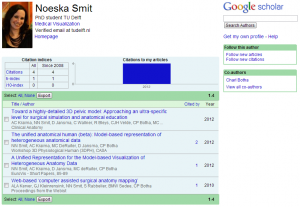I love the smell of new publications in the morning! This particular morning I woke up to a nice little e-mail from Google Scholar entitled ‘Review updates to your Google Scholar profile’. It featured a brand new publication for me to approve and to add to my Google Scholar profile:
- Toward a highly-detailed 3D pelvic model: Approaching an ultra-specific level for surgical simulation and anatomical education. A.C. Kraima, N.N. Smit, D. Jansma, C. Wallner, R.L.A.W. Bleys, C.J.H. v.d. Velde, C.P. Botha, M.C. Deruiter, Clinical Anatomy, December 2012
The first author for this journal paper is my co-worker on the Virtual Surgical Pelvis project from the Leiden University Medical Center: Annelot Kraima. She’s a medical doctor and works as a PhD student in the Anatomy and Embryology department. In this work, she gives a complete overview of all existing virtual 3D models of the pelvis and discusses the anatomical and technical challenges of creating a new model that includes enough detail to be useful in surgical applications. The abstract for this work can be found below and the full paper can be found here:
“The surgical anatomy of the pelvis is highly complex. Anorectal and urogenital dysfunctions occur frequently after pelvic oncological surgery and are mainly caused by surgical damage of the autonomic nerves. A highly-detailed 3D pelvic model could increase the anatomical knowledge and form a solid basis for a surgical simulation system. Currently, pelvic surgeons still rely on the preoperative interpretation of 2D diagnostic images. With a 3D simulation system, pelvic surgeons could simulate and train different scenes to enhance their preoperative knowledge and improve surgical outcome. To substantially enrich pelvic surgery and anatomical education, such a system must provide insight into the relation between the autonomic network, the lymphatic system, and endopelvic fasciae. Besides CT and MR images, Visible Human Datasets (VHDs) are widely used for 3D modeling, due to the high degree of anatomical detail represented in the cryosectional images. However, key surgical structures cannot be fully identified using VHDs and radiologic imaging techniques alone. Several unsolved anatomical problems must be elucidated as well. Therefore, adequate analysis on a microscopic level is inevitable. The development of a comprehensive anatomical atlas of the pelvis is no straightforward task. Such an endeavor involves several anatomical and technical challenges. This article surveys all existing 3D pelvic models, focusing on the level of anatomical detail. The use of VHDs in the 3D reconstruction of a highly-detailed pelvic model and the accompanying anatomical challenges will be discussed”
While I’m posting anyway, I’d also like to briefly discuss the benefits of setting up your Google Scholar Citations profile. When you visit Google Scholar, you may have noticed a ‘My Citations’ link at the top of the page. Getting your own profile allows you to track citations (and see pretty graphs of them), compute metrics such as the h-index, view publications by researchers you’re interested in and allows you to make sure that the search results that show up when someone googlescholars (is that even a verb? (it is now!)) your name are in fact your publications. Boosting your professional researcher web presence by having a public profile of your publications and citations such as this is of course never a bad thing. It’s the researcher’s equivalent of e-peen basically. Here‘s mine:

So how can you get one of these Google Scholar Citations profiles? It’s incredibly easy! After logging using your Google account, you’re able to fill out your details: name, position, e-mail address (work e-mail) and interests. The next step is to add your publications so far and choose the way you would like to update your future publications. There are two options for this: you can either have Google attempt to do this automatically or, if you like being e-mailed and having control over the process, you can select the option to approve Google’s suggestions manually. So if you don’t have one already, create one now and watch that h-index soar (eventually)!